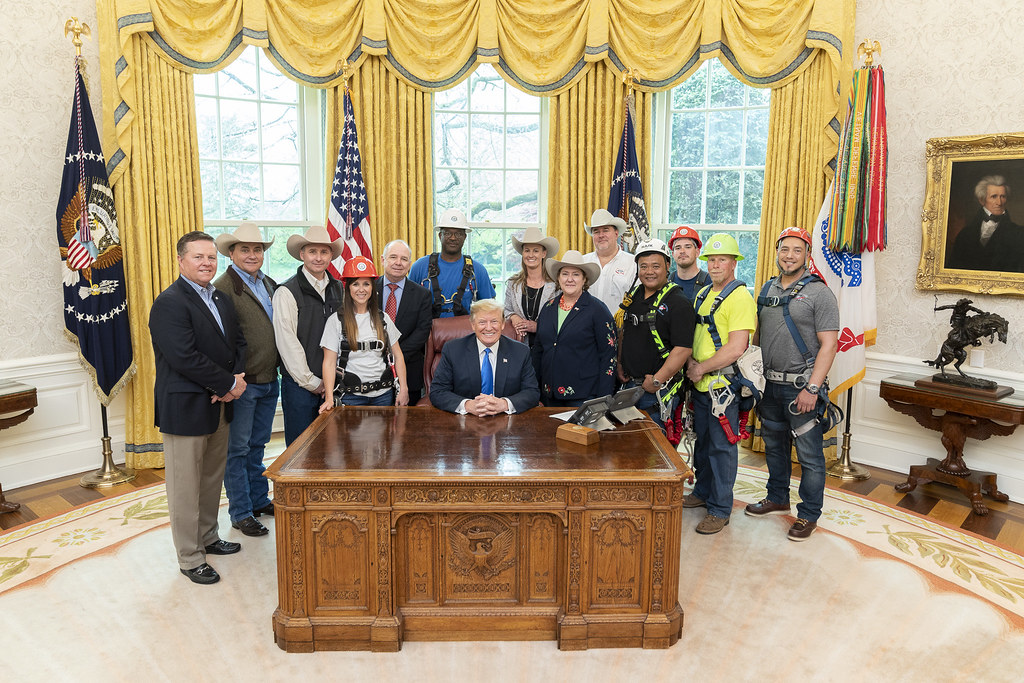SinoTech: U.S. and China Reach Agreement on Enforcement Provisions, Edging Closer to a Trade Deal
Treasury Secretary Steven Mnuchin revealed last week on CNBC that U.S. and Chinese negotiators have reached agreement on an “enforcement mechanism” as part of negotiations over a bilateral trade deal. Mnuchin specified that both sides “will establish enforcement offices that will deal” with matters of compliance.

Published by The Lawfare Institute
in Cooperation With

Treasury Secretary Steven Mnuchin revealed last week on CNBC that U.S. and Chinese negotiators have reached agreement on an “enforcement mechanism” as part of negotiations over a bilateral trade deal. Mnuchin specified that both sides “will establish enforcement offices that will deal” with matters of compliance. Over the weekend, Mnuchin further underlined the two-way nature of the proposed enforcement system, noting that the U.S. is willing to face “repercussions” if it does not hold up its end of the trade deal.
Robert Lighthizer, the U.S. trade representative, has yet to comment on recent progress over enforcement provisions, but if Mnuchin is right, that would mean negotiators have cleared one of the biggest hurdles to a potential trade deal. Lighthizer has consistently stressed the importance of effective enforcement mechanisms. In late February, he told the House Ways and Means Committee that negotiators had agreed to an enforcement mechanism consisting of semiannual gatherings at the ministerial level—that is, between Lighthizer and Chinese Vice Premier Liu He—as well as more frequent meetings at lower levels. The relationship between the meetings detailed by Lighthizer and the enforcement offices detailed by Mnuchin has not been clarified.
The Chinese have emphasized throughout negotiations that any trade deal needs to impose responsibilities on both parties. Wang Shouwen, a top negotiator, put it bluntly: The new trade regime must be “two-way, fair and equal.” Mnuchin’s recent statement that the U.S. is willing to face Chinese repercussions indicates that American negotiators have taken heed of their counterparts’ position, at least to some extent. The focus on two-way enforcement, however, may meet domestic opposition. As a Financial Times article said, “[A]llowing China to impose punitive measures on the U.S. … could raise eyebrows in corporate America, since they would likely be on the receiving end of those countermeasures”—countermeasures that the U.S. “would have committed not to challenge in the WTO [World Trade Organization].”
Still, agreement over enforcement mechanisms means that negotiations are likely entering the “final round,” to borrow Mnuchin’s phrase. American and Chinese negotiators have successfully worked through a number of other issues too. American officials have indicated that both sides agreed to measures that would deter Beijing from currency manipulation. Yi Gang, governor of the People’s Bank of China, had already stated last month that China would no longer engage in “competitive devaluation.” Moreover, according to the New York Times, “negotiators have already worked out the bulk of a 150-page agreement on issues including intellectual property protections, purchases, [and] subsidies.”
Trump Administration Unveils New 5G Efforts Amid Concerns Over Chinese Equipment
The Federal Communications Commission (FCC) unveiled on April 12 a set of new efforts to facilitate the rollout of 5G networks in the United States. The initiative comes amid mounting concerns about the dominance of Chinese companies in the market for 5G network equipment. 5G refers to the fifth generation of mobile networks, which will operate at higher speeds and facilitate new technologies such as autonomous vehicles and smart cities.
The 5G initiative consists of two main components. First, in December, the FCC plans to hold its biggest-ever auction for high-frequency airwaves in which it will auction to mobile carriers as much as 3.4 gigahertz (GHz) of “millimeter-wave” spectrum airwaves. Expanding access to airwaves in this spectrum will allow more providers to build out their networks and provide services to support machine-to-machine communications. The FCC is currently seeking comment on the auction bidding procedures, which will be for access to space in the upper 37 GHz, 39 GHz and 47 GHz bands. (Currently two carriers—Verizon and AT&T—already have early-stage networks operating in the United States as an evolution built on existing 4G infrastructure.)
Second, FCC Chairman Ajit Pai announced the launch of a $20.4 billion Rural Digital Opportunity Fund to encourage the construction of fiber-optic cable networks in rural areas. The construction of such infrastructure will help reduce the current “digital divide” between those with strong internet access and those without. The announcement also emphasized the role of the private sector in building the United States’s 5G networks. Some advisers had advocated that the Trump administration pursue a government-operated nationwide 5G network comparable to the model used by China, where the government controls the major mobile operators. Last week’s rollout, however, made clear that the nationalization idea would not be adopted.
At the announcement of the 5G initiative, which highlighted both the Rural Digital Opportunity Fund and the airwave auction, President Trump framed the issue starkly in terms of geopolitical competition, declaring, “The race to 5G is on and America must win,” and underscoring that the U.S. could not permit “any other country to outcompete the United States” in this area. The role of Chinese companies in providing 5G network equipment—particularly Huawei and ZTE—has drawn increasing scrutiny in both the United States and Europe. The U.S. government has cited national security risks and the potential for espionage in pressuring its allies to avoid Huawei equipment. While an executive order banning the use of Huawei equipment in the United States has long been under consideration, no such announcement accompanied the Trump administration’s latest 5G initiative.
The Trump administration’s efforts may accelerate the creation of 5G networks in the United States, but the country still lacks a major domestic producer of 5G network equipment like the Chinese firms Huawei and ZTE. Additionally, while the United States has been earlier to roll out commercial 5G services, which Chinese firms don’t plan to do until 2020, China has taken the lead on the construction of national 5G infrastructure and expects to complete the process by 2023.
In Other News
- According to the Nikkei Asian Review, California-based Applied Materials, a materials engineering firm that makes chips and display equipment, has “halted all deliveries and servicing” for Xiamen San’an Optoelectronics, China’s “biggest LED chip maker.” Applied Materials decided to halt business with the Chinese company immediately after the U.S. Department of Commerce’s Bureau of Industry and Security placed the company on its “Unverified List,” which was updated most recently on April 11. The Unverified List contains the addresses and names of parties whose bona fides—“i.e., legitimacy and reliability relating to the end use and end user of items”—the bureau has been unable to verify. The list does not “embargo dealings with listed entities,” but it does require “American companies to treat them with caution.”
- Chinese authorities have employed a sweeping facial-recognition technology system to identify and track the movements of the 11 million members of the Uighur ethnic minority. According to the New York Times, this “is the first known example of a government intentionally using artificial intelligence for racial profiling.” Although high degrees of surveillance in the autonomous region of Xinjiang have been well documented, recent reports suggest use of video cameras and other surveillance devices has become more widespread in other parts of the country. While government agencies and police departments are the main purchasers of cameras and facial recognition software, the controversy over racial profiling in Xinjiang has also drawn attention to the large private firms that produce the technology, including CloudWalk, SenseTime, Yitu, Megvii, and Hikvision.
- The People’s Bank of China released its March credit data on April 12. As Bloomberg reports, Chinese credit growth “exceeded all estimates … signaling a further firming of the nascent economic recovery ahead.” Aggregate financing “totaled 2.86 trillion yuan” in March, “compared with about 700 billion yuan in February.” According to Axios China, these figures indicate that Chinese policymakers have added “credit growth to all the other stimulative measures … to keep the economy stable” and that such efforts “may be working, at least in the short term.”
- There continues to be, however, a more troubling side to the China credit story. Caixin has released a two-part, in-depth investigation into the “local government debt crisis that just won’t go away.” In the articles, Caixin journalists contend that “local government debt, in particular the trillions of yuan of liabilities in financing vehicles, is threatening to overwhelm dozens of authorities across the country.” The total debt of local governments amounts to ”more than 70% of the country’s” 2018 GDP,” according to Chinese officials. The investigation focused on Zhenjiang, a city in China’s eastern Jiangsu province, and on how the city is struggling to repay debt issued by local government financing vehicles.
- The Wall Street Journal has reported that Chinese e-commerce firm JD.com is cutting costs, laying off employees and closing foreign offices in order to “cope with a slowing economy and rising competition.” Last week, Richard Liu, JD’s chief executive, wrote a scathing post on his WeChat feed, arguing that his firm was filled with “slackers.” In recent weeks, the Chinese tech scene has been racked by debate over the “996 schedule,” a common schedule at a number of Chinese tech firms whereby employees work from 9 am to 9 pm, six days a week. Jack Ma, founder of the Alibaba Group, initially defended that schedule before changing tack this past weekend and decrying a forced 996 schedule as “inhumane” and “unsustainable.” Clearly, however, JD’s financial woes are not just a function of employee laziness; as the Wall Street Journal contends, the trade war has “crimp[ed] financial and consumer spending” and the rise of e-commerce competitors has likewise cut into JD’s profit margins.
Commentary
For Brookings, Sarah Bauerle Danzman and Geoffrey Gertz discuss whether Beijing Kunlun Tech’s stake in the dating app Grindr really poses a national security threat, as a recent Committee on Foreign Investment in the United States review suggests. At the Center for Strategic and International Studies, James Lewis assesses whether the woman who recently appeared at Mar-a-Lago was actually engaging in espionage for the Chinese government. As part of the New York Times’s new privacy project, Jianan Qian describes how the rise of technological surveillance has altered Chinese attitudes toward public security.
At Project Syndicate, Joseph Nye considers whether the United States has been overestimating China’s future strength. Niall Ferguson wonders whether the United States will be able to balance China’s power as more European countries are drawn to trade deals with China. Eswar Prasad and Ethan Wu warn of a dimming outlook on global trade in the Nikkei Asian Review. Meanwhile, in the Financial Times, Janan Ganesh analyzes the underlying issues in the U.S.-China relationship that President Trump’s fixation on trade currently obscures. Australian National University released its annual China Story Yearbook; this year’s theme is “power,” and the book encompasses articles on everything from military bases to e-commerce.
For Lawfare, Bobby Chesney considers what recently obtained Foreign Intelligence Surveillance Act (FISA) orders against Huawei may reveal about the company’s relationship to the Chinese government, while Stephanie Zable offers context on Huawei’s recently filed lawsuit against the U.S. government. Herb Lin analyzes common themes in AI governance proposals from Google, Microsoft, and Salesforce. Meanwhile, Cameron Kerry proposes language on data collection for a possible federal privacy law, and Michael P. Fischerkeller and Richard J. Harknett discuss how nations can work toward a state of “agreed competition” in cyberspace. On the Cyberlaw Podcast, Stewart Baker interviews Adam Segal of the Council on Foreign Relations on where the U.S.-China relationship is headed with respect to trade and technology (at 38:50) and discusses the outcomes of the EU-China Summit with Matthew Heiman (at 26:00).






